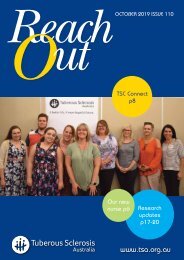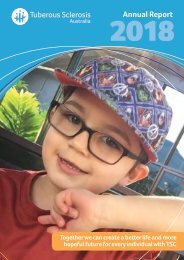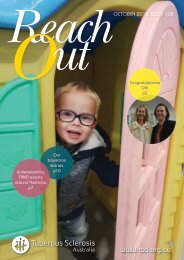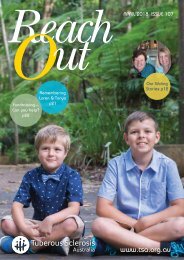Reach Out April 2019
Create successful ePaper yourself
Turn your PDF publications into a flip-book with our unique Google optimized e-Paper software.
Information<br />
Issues in<br />
TAND<br />
Clare Stuart<br />
TAND stands for ‘tuberous sclerosis associated<br />
neuropsychiatric disorders’ and includes the challenges<br />
that people with tuberous sclerosis complex (TSC) have with<br />
behaviour, mental health, learning, autism, brain skills, attention<br />
and intellectual disabilities.<br />
In 2018, Tuberous Sclerosis Australia (TSA) held<br />
‘Understanding TAND’ events in three Australian cities with<br />
international expert in TAND, Professor Petrus de Vries, from the<br />
University of Cape Town South Africa.<br />
As a part of these events, we explored three questions:<br />
• Which aspects of TAND have the biggest impact on the lives<br />
of people with TSC?<br />
• What resources, such as professionals, organisations and<br />
treatments, are helpful?<br />
• What are the biggest gaps where we can help the Australian<br />
TSC community with the challenges of TAND?<br />
In this article, we summarise some of the issues that emerged<br />
in these discussions with the diverse group of participants at<br />
these events along with Australian professionals. We also held a<br />
discussion on TAND at our 2017 Melbourne TSC Information Day.<br />
You can read an overview of TAND, including downloading the<br />
TAND checklist screening tool, on our TAND information page at:<br />
www.tsa.org.au/information/tand<br />
One of the challenges<br />
people with TSC experience is<br />
seeking a diagnosis for various<br />
aspects of TAND<br />
The uniqueness of TAND<br />
The one common theme of discussions at our events was that each<br />
person with TSC is different. Research into TAND has also shown<br />
that each person with TSC has a unique profile of aspects of TAND<br />
that affect them. Another challenge people with TSC find is the<br />
way an individual’s TAND profile changes throughout their life.<br />
Using the TAND checklist and regular assessments, particularly at<br />
key developmental and life stages, can help to stay on top of issues.<br />
To label or not to label?<br />
One of the challenges people with TSC experience is seeking a<br />
diagnosis for various aspects of TAND. A diagnosis, such as autism<br />
or attention deficit and hyperactivity disorder (ADHD), may be<br />
helpful to understand the person with TSC and also to access<br />
therapies and funding for these therapies.<br />
Sometimes TAND challenges will be overshadowed by the<br />
diagnosis of TSC, and professionals will consider the symptoms<br />
to be just part of TSC and not a separate diagnosis. Sometimes<br />
professionals will be particularly reluctant to diagnose because they<br />
know labels can be difficult to remove once they are given. If the child<br />
has a developmental delay, the professional may be unsure whether<br />
the challenges, for example with communication, are related to the<br />
developmental delay or if they will continue separately from the delay.<br />
But we know that people with TSC are at significant risk of<br />
various aspects of TAND, including autism, attention deficit<br />
hyperactivity disorder (ADHD) and learning disabilities. This<br />
means that they are likely to benefit from early intervention and<br />
often a diagnosis is required to access appropriate interventions.<br />
One Australian expert suggested that red flags for autism can be<br />
useful to trigger a detailed assessment for autism. Child Health<br />
Queensland has a useful list at:<br />
www.childrens.health.qld.gov.au/wp-content/uploads/PDF/<br />
red-flags-a3.pdf<br />
Attention and impulse control challenges<br />
and interventions<br />
Many people with TSC experience difficulties with sustaining<br />
attention, hyperactivity and controlling impulses. Many people<br />
with TSC find movement breaks are a relatively simple strategy<br />
that can help hugely in the classroom or at work.<br />
Professionals recommend that, when these challenges meet the<br />
criteria for ADHD, medication can be a useful tool in combination<br />
with other interventions and strategies.<br />
A paediatrician is the best starting point for assessment of ADHD<br />
in children. In adults, this process will usually start with a psychiatrist.<br />
Understanding challenging behaviours<br />
All groups spoke about challenging behaviours, including<br />
aggression, as a major impact of TAND on the person with<br />
TSC and their family. Discussions identified both anxiety and<br />
difficulties with impulse control as a possible underlying cause of<br />
these behaviours.<br />
To help with behaviours that challenge the person with TSC<br />
or those around them, many ideas were shared at our events. One<br />
place to start is to try to understand the meaning or function of the<br />
behaviour. One tool to help with this is called the ABC approach,<br />
which stands for:<br />
• Antecedents (what happened before the behaviour?)<br />
• Behaviour (what is the actual behaviour?)<br />
• Consequences (what happens afterward?)<br />
There is more information about this approach at:<br />
www.synapse.org.au/information-services/abc-approach-tounderstanding-behaviour<br />
The developmental behaviour checklist can be a useful tool for<br />
professionals to assist with diagnosis and for monitoring interventions.<br />
20<br />
<strong>Reach</strong><br />
<strong>Out</strong><br />
APRIL <strong>2019</strong> ISSUE 109


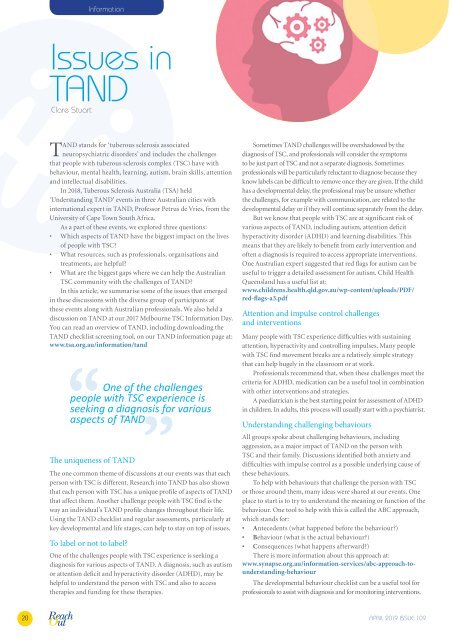


![TSA Reach Out April 2022 [Final]](https://documents.yumpu.com/000/066/687/587/3d369bd665bdb406a759500f62e2cfad0ccb7b3d/47512b4a703265727550565249426664566a727454513d3d/396a524e7354316d3867454b587243526164724c52673d3d.jpg?AWSAccessKeyId=AKIAICNEWSPSEKTJ5M3Q&Expires=1716166800&Signature=9kKM8SNcC9vmeEhpqZ8%2FgmVz9lE%3D)
![TSA AR 2021 [WEB] (1)_FINAL](https://documents.yumpu.com/000/065/886/431/1afb21934ac6c444cd384e5fd7403d62e47080ce/426853747566526573646568546777594b4a4a5734513d3d/547274595943503850786275754544495972536c52513d3d.jpg?AWSAccessKeyId=AKIAICNEWSPSEKTJ5M3Q&Expires=1716166800&Signature=w5g4R7ZDimnSWUUx0l9dXSO52Q8%3D)

![TSA Reach Out Apr 2021 [WEB]](https://documents.yumpu.com/000/065/442/909/1e583cb2acba0eaa7f1aae53e14a0cf408aa56c4/7871796d694459464d707163324830746459484671673d3d/45356637637a3369494f764f4c3858495549795251513d3d.jpg?AWSAccessKeyId=AKIAICNEWSPSEKTJ5M3Q&Expires=1716166800&Signature=TR3FzioRmtLTh%2Bm3YeitLTf75%2Bs%3D)




